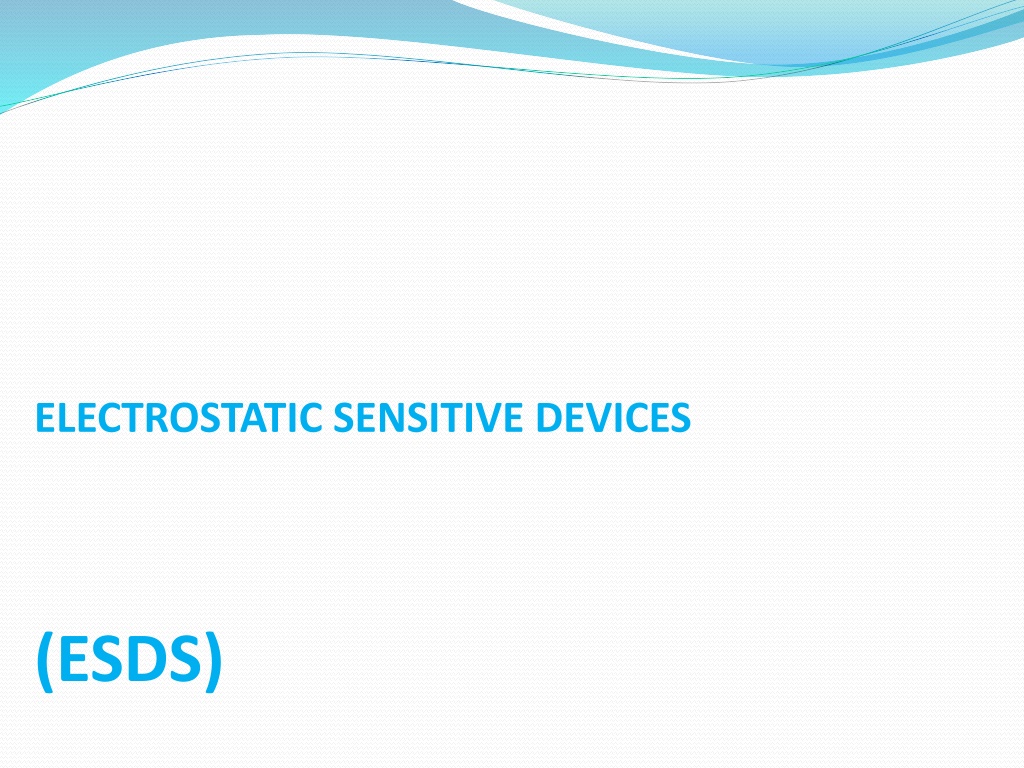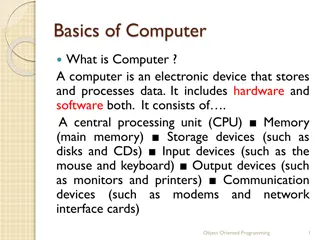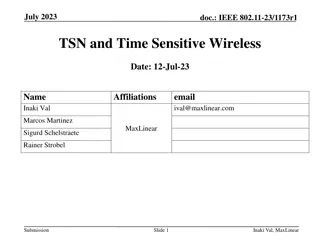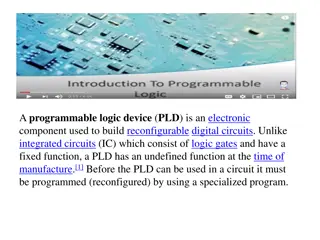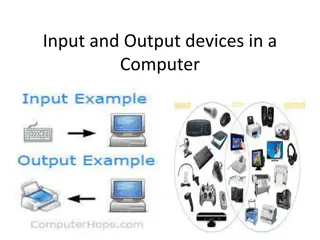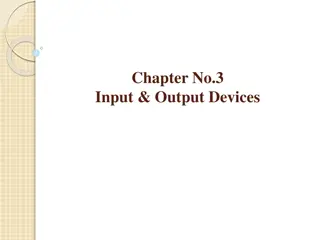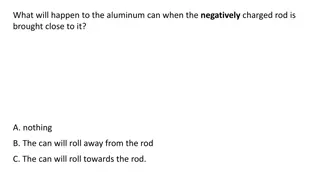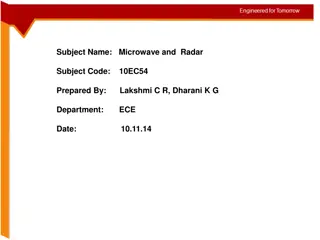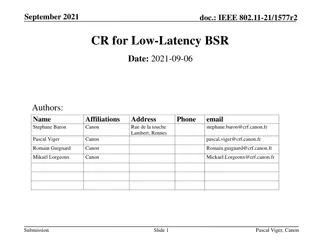Understanding Electrostatic Sensitive Devices (ESDS)
Electrostatic Sensitive Devices (ESDS) are susceptible to damage caused by electrostatic discharge (ESD). This results from the transfer of electrostatic charge induced by high electrical fields. ESD can alter the characteristics of semiconductor devices, leading to malfunctions or failures in electronic systems. Triboelectric charging, the creation of electrostatic charge through material contact and separation, plays a crucial role in generating static electricity. It is essential to protect ESDS to prevent potential harm and maintain product yields in electronic manufacturing.
- Electrostatic Sensitive Devices
- ESDS
- Electrostatic Discharge
- Triboelectric Charging
- Semiconductor Devices
Download Presentation

Please find below an Image/Link to download the presentation.
The content on the website is provided AS IS for your information and personal use only. It may not be sold, licensed, or shared on other websites without obtaining consent from the author. Download presentation by click this link. If you encounter any issues during the download, it is possible that the publisher has removed the file from their server.
E N D
Presentation Transcript
Introduction Generation of electrostaticcharge Material characteristics affect staticcharge ESD damage Effect on electronic devices Protection for electrostatic discharge sensitive (ESDS) devices
Electrostatic charge is defined as electric charge at rest . Static electricity is an imbalance of electrical charges withinoron the surfaceof a material. This imbalance of electrons produces an electric field that can be measured and that can influence other objects. Electrostaticdischarge (ESD) isdefined as the rapid, spontaneous transfer of electrostatic charge induced by a high electrostatic field. Usually, the charge flows through a spark between two bodiesatdifferentelectrostaticpotentials as theyapproachoneanother .
Electrostatic discharge can change the electrical characteristics of a semiconductor device, degrading or destroying it. Electrostatic discharge also may upset the normal operation of an electronic system, causing equipment malfunction or failure. Charged surfaces can attract and hold contaminants, making removal of theparticlesdifficult. When attracted to the surface of a silicon wafer or a device's electrical circuitry, air-borne particulates can cause random wafer defects and reduce product yields.
Creating electrostatic charge by contact and separation of materials is known as "triboelectric charging. It involves the transfer of electrons between materials. The atoms of a material with no static charge have an equal number of positive (+) protons in their nucleus and negative (-) electrons orbiting the nucleus. In Figure , Material "A" consists of atoms with equal numbers of protons and electrons. Material B also consists of atoms with equal (though perhaps different) numbers of protons and electrons. Both materials are electrically neutral.
When the two materials are placed in contact and then separated, negatively charged electrons are transferred from the surface of one material to the surface of the other material. Which material loses electrons and which gains electrons will depend on the nature of the two materials. The material that loses electrons becomes positively charged, while the material that gains electrons is negatively charged. This is shown in Figure. Static electricity is measured in coulombs. The charge q on an object is determined by the product of the capacitance of the object C and the voltage potential on the object (V): q = CV Commonly, however, we speak of the electrostatic potential on an object, which is expressed as voltage.
This process of material contact, electron transfer and separation is a much more complex mechanism than described here. The amount of charge generation is affected by the area of contact, the speed of separation, relative humidity, and chemistry of the materials, surface work function and other factors. Once the charge is created on a material, it becomes an electrostatic charge (if it remains on the material). This charge may be transferred from the material, creating anelectrostaticdischargeor ESD event. created by triboelectric
Additional factors, such as the resistance of the actual discharge circuit and the contact resistance at the interface between contacting surfaces also affect the actual charge that is released. In addition, the contribution of humidity to reducing charge accumulation. It should be noted that static charge generation still occurs even at high relative humidity. An electrostatic charge also may be created on a material in other ways such as by induction, ion bombardment, or contact with another charged object. However, triboelectric charging is the most common.
Triboelectric Series :-When two materials contact and separate, the polarity and magnitude of the charge are indicated by the materials positions in a triboelectric series. Insulative Materials :-Material that prevents or limits the flow of electrons across its surface or through its volume is called an insulator. Insulators have an extremely high electrical resistance, insulative materials are defined as materials with a surface resistance or a volume resistance equal to or greater than 1 1011 ohms. A considerable amount of charge can be generated on the surface of an insulator.
Because an insulative material does not readily allow the flow of electrons, both positive and negative charges can reside on insulative surface at the same time, although at different locations. The excess electrons at the negatively charged spot might be sufficient to satisfy the absence of electrons at the positively charged spot. However, electrons cannot easily flow across the insulative material's surface, and both charges may remain in place for a very long time. Conductive Materials:-A conductive material, because it has low electrical resistance, allows electrons to flow easily across its surface or through its volume. Conductive materials have low electrical resistance, less than 1 104 ohms (surface resistance) and 1 104 ohm (volume resistance) per ESD ADV1.0.
When a conductive material becomes charged, the charge (i.e., the deficiency or excess of electrons) will be uniformly distributed across the surface of the material. If the charged conductive material makes contactwith another conductive material, the electrons will be shared between the materialsquiteeasily. If the second conductor is attached to A/C equipment, ground or any other grounding point, the electrons will flow to ground and the excess charge on the conductorwill be neutralized. Static Dissipative Materials:- materials have an electrical insulative and conductive materials (1 104 to 1 1011 ohms surfaceorvolumeresistance). Static resistance dissipativ between
There can be electron flow across or through the dissipative material, but it iscontrolled by thesurface resistanceorvolumeresistanceof the material. As with the other two types of materials, charge can be generated triboelectricallyon astatic dissipative material. However, like the conductive material, the static dissipative material will allow the transfer of charge to ground or other conductiveobjects. The transferof charge from a static dissipative material will generallytake longerthan fromaconductive material of equivalentsize. Charge transfers from static dissipative materials are significantly faster than from insulators, and slower than from conductive material.
Electrostatic Fields :- Charged materials also have an electrostatic field and lines of force associated with them. Conductive objects brought into the vicinity of this electric field will be polarized by a process known as induction . A negative electric field will repel electrons on the surface of the conducting item that is exposed to the field. A positive electric field will attract electrons to near the surface thus leaving other areas positively charged. No change in the actual charge on the object will occur in polarization.
If, however, the item is conductive or dissipative and is connected to ground while polarized, the charge will flow from or to ground due to the charge imbalance. If the electrostatic field is removed and the ground contact disconnected, the charge will remain on the item. If a nonconductive object is brought into the electric field, the electrical dipoles will tend to align with the field creating apparent surface charges. A nonconductor (insulative material) cannot be charged by induction.
Electrostatic damage is defined as change to an item caused by an electrostatic discharge that makes it fail to meet one or more specified parameters. and can occur at any point from manufacture to field service. Typically, damage results from handling the devices in uncontrolled surroundings or when poor ESD control practices are used. Generally damage is classified as either a catastrophic failure or a latent defect
Catastrophic Failure When an electronic device is exposed to an ESD event, it may no longer function. The ESD event may have caused a metal melt, junction breakdown, or oxide failure. The device's circuitry is permanently damaged causing the device to stop functioning totally or at least partially. Such failures usually can be detected when the device is tested before shipment. If a damaging level ESD event occurs after test, the part may go into production and the damage will go undetected until the device fails in final test.
Latent Defect As per ESD ADV1.0 latent failure is a malfunction that occurs following a period of normal operation. The failure may be attributable to an earlier electrostatic discharge event. The concept of latent failure is controversial and not totally accepted by all in the technical community. A latent defect is difficult to identify. A device that is exposed to an ESD event may be partially degraded, yet continue to perform its intended function. However, the operating life of the device may be reduced.
A product or system incorporating devices with latent defects may experience premature failure after the user places them in service. Such failures are usually costly to repair and in some applications may create personnel hazards. It is relatively easy with the proper equipment to confirm that a device has experienced a catastrophic failure. Basic performance tests will substantiate device damage. However, latent defects are extremely difficult to prove or detect using current technology, especially after the device is assembled into a finished product.
ESD damage is usually caused by one of three events: direct electrostatic discharge to the device, electrostatic discharge from the device or field-induced discharges. The level at which a device fails is known as the device s ESD sensitivity or ESD susceptibility. Discharge to the Device:- An ESD event can occur when any charged conductor (including the human body) discharges to an item. A cause of electrostatic damage could be the direct transfer of electrostatic charge from the human body or a charged material to the ESDS.
The model used to simulate this event is the Human Body Model (HBM). A similar discharge can occur from a charged conductive object, such as a metallic tool or fixture. From the nature of the discharge, the model used to describe this event is known as the Machine Model (MM). Discharge from the Device:- The transfer of charge from an ESDS to a conductor is also an ESD event. Static charge may accumulate on the ESDS itself through handling or contact and separation with packaging materials, work surfaces, or machine surfaces.
This frequently occurs when a device moves across a surface or vibrates in a package. The model used to simulate the transfer of charge from an ESDS is referred to as the Charged Device Model (CDM). Field Induced Discharges:- Another electrostatic charging process that can directly or indirectly damage devices is termed Field Induction. Whenever any object becomes electrostatic ally charged, there is an electrostatic field associated with that charge. If an ESDS is placed in that electrostatic field, a charge may be induced on the item.
If the item is then grounded while within the electrostatic field, a transfer of charge from the device occurs as a CDM event. If the item is removed from the region of the electrostatic field and grounded again, a second CDM event will occur as the charge (of opposite polarity from the first event) is transferred from the device.
Work area:- It is essential to handle ESDS devices at static-safe workstations. This will prevent yield loss (through catastrophic damage) reliability failures in the field (through latent damage). Where it is impractical or impossible to use antistatic wrist-straps or remove items that are composed of insulative materials at a static-safe workstation, use an air ionizer designed to neutralize electrostatic charges or apply topical antistats to control generation and accumulation of staticcharges. or, worse, potential
When an air ionizer is utilized, it is vital that maintenance procedures and schedules are adhered to in order to ensure that ions generated by the ionizer are sufficiently balanced. Avoid bringing sources of static electricity within 1 meter of a static-safe work bench. Where it is necessary to use air-guns, use special models that do not generate static charges in the air stream.
Personnel: - Any accumulated charge on the body of the human operator should be discharged first before opening the protective container with ESDS devices inside. The discharge can be accomplished by putting a hand on a grounded surface or, ideally, by wearing a grounded antistatic wrist-strap. The use of an antistatic smock for each worker is highly recommended. Education and training on ESD preventive measures is invaluable. A regular audit is also helpful in supporting an ESD program.
Packaging and Transportation:- ESDS devices should be contained in a static protective bag or container at all times during storage or transportation. Static-safe work bench:- The diagram below shows a typical static-safe work bench. The table top is covered by a static dissipative mat which is grounded through a 1 Meg-ohm resistor. This resistor is required in order to protect the users of the static-safe work bench in the event that the ground becomes electrically live, the resistor will prevent electrical shock at the work bench. The same safety requirement holds true for the antistatic wrist-strap as well.
It is recommended that static dissipative materials are used as the medium (e.g. mats, containers) for discharging static charge to ground. These materials have the following properties: Surface resistivity: 1 x 105to 1 x 1012 ohms/m2 Volume resistivity: 1 x 104to 1 x 1011ohm-cm
An example of a static-safe work bench (at Electrical Test).
Where a wrist-strap is impractical, e.g. the job requires the worker to walk from one location to another, it is recommended that antistatic footwear such as antistatic shoes or heel- straps are worn. The following fig. shows an example of an antistatic heel-strap with the grounding cord running into the socks to make contact with the skin. It is also necessary to use an antistatic floor (e.g. conductive floor tiles) to work together with the antistatic footwear.
The following labels are commonly used on containers and packaging to alert anyone who handles the ESDS devices on the need to use static-safe procedures before handling the devices. The one on the left is preferred.
